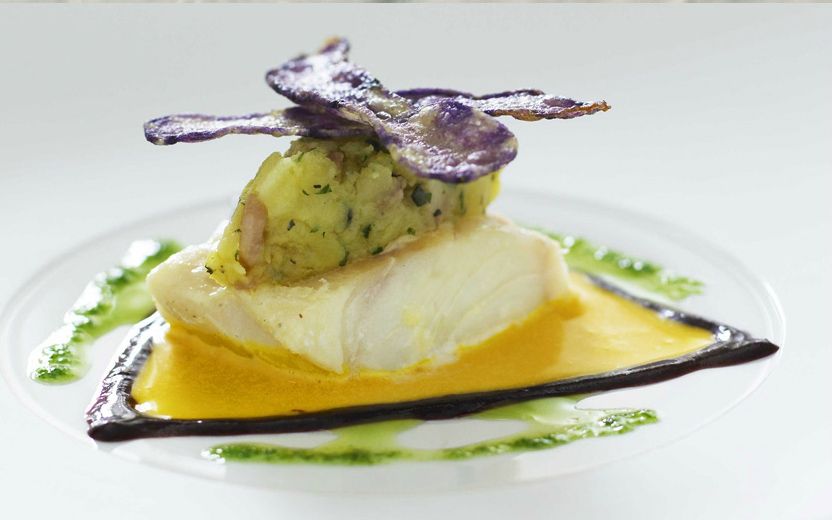
For the past several years, the countries of Northern Europe have dominated the world culinary stage with a revolutionary style of food that utilizes both the bounty of the sea and foraged ingredients in ingenious new combinations and preparations. Dubbed New Nordic cuisine, this style’s impact can be felt the world round as more and more restaurants are sourcing products right from their own backyards.
At the top of this foodie chain is a single restaurant, Noma, which has garnered the top spot on Restaurant Magazine’s and San Pellegrino’s prestigious list of the World’s 50 Best Restaurants for four out of the past five years.
However, if you don’t have the luck to score a hard-to-snag table at René Redzepi's Copenhagen hotspot, you can still sample New Nordic cuisine at a slew of impressive new restaurants (and some old) that are helmed by talented young chefs throughout Scandinavia. Here are a few of the best:

Falsled Kro
Funen, Denmark
Only a 90-minute drive from Copenhagen, Falsled Kro might rightfully be seen as the forerunner of the New Nordic tradition. This Relais & Chateaux property (there is a small luxury hotel here as well) actually dates to the 16th-century, when it was a notorious smugglers’ inn along the coast of the Danish island of Funen. Though the current buildings are more recent, there is still a palpable sense of history in the whitewashed brick buildings, thatched roofs and the leafy, cobbled inner courtyards—the restaurant is a glassed-in dining room overlooking a green lawn with an outdoor fireplace.
Falsled Kro’s current history begins in the 1970’s when a Danish couple bought the old inn, refurbished it, and brought in French chef Jean-Louis Lieffroy, who quickly earned a reputation as one of Denmark’s best chefs by incorporating Funen’s local produce—both seafood, as well as fruits and grains—and his own classic French training. These days, the restaurant is overseen by Randi Schmidt and Per Hallundbæk, carrying on the establishment's palate-pleasing tasting menus.

A typical dinner here might include a little nibble of tangy skyr mousse with smoked salmon, balsamic quail eggs and duck prosciutto-wrapped asparagus; or the signature dish of a fried poached egg with smoked eel and fresh sorrel sauce for a hint of green earthiness. Springtime main courses include classics like tender squab with minced mushroom duxelles and a purée of peas and green asparagus in birch sauce—only Scandinavians could make tree bark taste this good. Then for dessert, a complex play on a simple dish: fresh-picked strawberries and cream get the Falsled Kro treatment with elderflower cream and gelée.
If you visit during the summer, nearly all of the produce you will be treated to will have been grown in the hotel’s own garden - including that soothing cup of anise tea you might sip to finish your meal.

Oaxen Krog & Slip
Stockholm, Sweden
A few hours north in the Swedish capital, husband-and-wife team Magnus Ek and Agneta Green have been spearheading the foraging trend for over two decades at Oaxen—which was named after an island near the city where it was originally located for about 20 years. However, the couple closed the first incarnation in 2011 and relocated it to the island of Djurgården right in the heart of Stockholm proper, reconfiguring a former waterside boat shed into two conjoining restaurants.
Oaxen Slip is the more casual kitchen here, with floor-to-ceiling windows framing a little cove and brightly painted hulls hanging from the ceiling. Oaxen Krog is slightly more formal, where you can sample the signature 10-course menu (though in reality it is more like 20 courses after you factor in all the amuse-bouches, entrée-plat sorbets, and petit fours).

Magnus comes up with innovative ways of incorporating both traditional and new Swedish ingredients into his complex dishes. Cured local jamón comes grated into salty yet delicate flakes and is served with herbaceous tarragon cream, and grassy, deep-fried elderflower blossoms in a hearty broth; while langoustines hand-picked from the rocks off Oaxen are simply grilled on a hot limestone slab and seasoned with fresh rosemary, thyme and sage with smoked lard for flavor.

One of the meatier options is a cut of spring lamb flash fried then baked in a birch-bark box that lends it a woody bouquet and a tender texture that complements the roasted apples, mushrooms and onion in the fermented blueberry reduction that accompanies it. Dessert is a combination of sweet and earthy notes, like a sorbet of polypod ferns with licorice root, white chocolate cream, elderflower capers, and translucent slices of pear and caramelized fennel seeds.
True to the restaurant’s seasonal inspiration, you won’t find the same menu in winter as in summer (or spring or fall, for that matter)—though some dishes may stick around.

Lysverket
Bergen, Norway
What do you get when a chef who has trained in some of America’s most prestigious kitchens—including Per Se, Blue Hill at Stone Barns, and Alinea—returns to his native town in Norway and recruits a couple of his former colleagues? The answer is this ultra-contemporary restaurant in Bergen, Norway’s second-largest city and former capital.
At Lysverket, Chef Christopher Haatuft has set up shop in one of the Bergen Art Museum’s Art Deco buildings. The industrial-chic interior, starting with a wall of buzzing low-watt bulbs, is an intriguing divergence from the stark, white exterior. Think concrete ceilings and floors, exposed ventilation ducts, and burnished brass overhead lamps – but with cozy touches like shaggy throws and antique-inspired wall fixtures.

Here the chef and his team present guests with a constantly changing menu of ingredients gathered from Norway’s farthest reaches, which diners can choose to sample in three-, five- or nine-course menus. As you peruse the choices, start with an aquavit-based cocktail created by mixologist Joar Nicolayson. The top choice is the seasonal cocktail du jour, which in summer means a mix of aquavit, Prosecco, clementine juice, and rhubarb syrup. However, if wines are more your thing, there is no shortage of interesting options that are sourced mainly from Europe.
On one evening, the dishes included a starter of langoustine with umami shellfish ravioli wrapped in neat little gyoza-like bundles, along with roasted turnip, earthy-sweet morello cherries and a shellfish bisque. The herb-roasted red fish with octopus ink, braised and fried kale over a risotto of barley and dried gooseberries was a definite standout, but the showstopper was the smoky braised crispy bacon with salt-baked rutabaga, mustard leaves and leek in an elderflower gastrique. The meal ended with a trio of strawberries—fresh, dried and brandy-macerated—with some sour lime curd, bright basil syrup, and tiny dollops of crème fraiche.

Spis
Helsinki, Finland
Though Finland is technically not part of Scandinavia, it is a Nordic country and the New Nordic trend is alive and well there. Spis, which means "oven" or "fireplace" in Finnish, is a hole-in-the-wall hideaway that opened just two years ago and has only 18 seats (so make your reservations now). The space feels more like a coffee house than a restaurant thanks to the exposed cement floors and walls (accented with scattered pieces of tattered wallpaper) and simple table settings.
While Chef Jaakko Kinnunen’s menu is typically based on the fresh produce of the day, there are fish and meat entrées that cater to individual tastes. Plus, every diner’s personal requirements are taken into account when creating the menu for the table. Guests choose between four- and six-course tasting menus each night with optional wine pairings, many of which are natural or biodynamic wines from small European producers and are hand-selected by restaurant co-owner Jani Kinanen.

Though the menu changes frequently, the springtime signature dish is a large, creamy scallop served with parsnip foam and lavender for a great combination of starch and spice. On the other end of the spectrum, you’ll find childhood-inspired dishes like pickled cucumber with salted peanuts and peanut-cucumber paste to get you ready for the tangy nettle soup with nutmeg-fried cottage cheese. Prime your palate with a smoky, herbaceous birch granita with fennel pollen and then continue with a juicy cut of pork over cabbage and mustard before a dessert of rhubarb sorbet with caramelized milk.

Although a seat at Noma is pretty hard to come by if you do not have the wherewithal to call six months in advance as soon as reservations open for a specific date—and indeed many travelers do so and plan an entire Scandinavian trip around it!—the above restaurants prove that there is no shortage of wonderful New Nordic tables. These dynamic chefs are pioneering and building upon the trend by foraging for fresh homegrown ingredients and performing some amazing alchemy in the kitchen as they whip up dishes you will be hard-pressed to find anywhere else.














